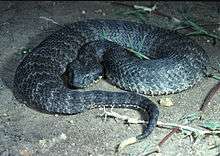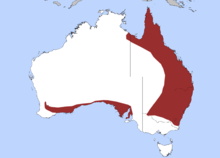Common death adder
The common death adder (Acanthophis antarcticus) is a species of death adder native to Australia. It is one of the most venomous land snakes in Australia and globally. While it remains widespread (unlike related species), it is facing increased threat from the ongoing Australian cane toad invasion.
| Common death adder | |
|---|---|
 | |
| Scientific classification | |
| Kingdom: | Animalia |
| Phylum: | Chordata |
| Class: | Reptilia |
| Order: | Squamata |
| Suborder: | Serpentes |
| Family: | Elapidae |
| Genus: | Acanthophis |
| Species: | A. antarcticus |
| Binomial name | |
| Acanthophis antarcticus (Shaw & Nodder, 1802) | |
 | |
| Distribution of the common death adder in Australia | |
| Synonyms[2] | |
|
List
| |
Taxonomy
The common death adder was first described in 1802 by George Shaw as Boa antarctica. French naturalist François Marie Daudin erected the genus Acanthophis in 1803, designating the common death adder (as A. cerastinus) as its only species.
Description
The common death adder has a broad flattened, triangular head and a thick body with bands of red, brown and black with a grey, cream or pink belly. It can reach a maximum body length of 70–100 centimetres (2.3–3.3 ft). Death adders possess the longest fangs of any Australian snake. Unlike the common or European adder (Vipera berus), the common death adder is a member of the snake family Elapidae, rather than the family Viperidae, which are not found in Australia.[3]
Distribution and habitat
The common death adder occurs over much of eastern and coastal southern Australia – Queensland, New South Wales, Victoria and South Australia. It is more scarce in the Northern Territory, Western Australia and the west parts of South Australia.[3] It is also native to Papua New Guinea.[1]
Common death adders are found in forests, woodlands, grasslands and heaths of the eastern coast of Australia. The death adder is a master of camouflage, due to its band stripes, hiding beneath loose leaf litter and debris in woodland, shrubland and grassland.[3]
Concerns
Loss of habitat and the spread of invasive Cane toads in Australia, are a concern. The toad eats young death adders and adult death adders that eat the toads are poisoned by the toxic glands on their skin, that is very deadly to Australian reptiles, and die.[4][5]
Diet
Common death adders eat small mammals and birds as a primary diet. Unlike other snakes, the common death adder lies in wait for its prey (often for many days) until a meal passes. It covers itself with leaves—making itself inconspicuous—and lies coiled in ambush, twitching its grub-like tail close to its head as a lure. When an animal approaches to investigate the movement, the death adder quickly strikes, injecting its venom and then waits for the victim to die before eating it. The death adder is not aggressive, yet its ambush hunting technique and reliance on camouflage rather than flight to avoid threats renders it more dangerous to humans who venture into bushland habitats.[3]
Reproduction
Unlike most snakes, death adders produce litters of live young. In the late summer, a female death adder will produce a litter of live offspring, approximately 3–20, however over 30 young have been recorded in a single litter.[3]
Venom
The common death adder venom contains highly toxic neurotoxin which can cause paralysis or even death. It can deliver the fastest strike among all venomous snakes recorded in Australia. Human death can occur within six hours after the bite.[3]
References
- Allison, A. (2015). "Acanthophis rugosus". IUCN Red List of Threatened Species. 2015: e.T177483A79355114. doi:10.2305/IUCN.UK.2015-3.RLTS.T177483A79355114.en.
- Australian Biological Resources Study (22 August 2013). "Species Acanthophis antarcticus (Shaw & Nodder, 1802)". Australian Faunal Directory. Canberra, Australian Capital Territory: Department of the Environment, Water, Heritage and the Arts, Australian Government. Retrieved 8 May 2019.
- "Common Death Adder". Archived from the original on November 1, 2012. Retrieved 1 December 2015.
- "Common Death Adder". Australian Wildlife. Retrieved 28 December 2018.
- "Death adders more endangered than dangerous". ABC Wide Bay. 2009-02-20. Retrieved 28 December 2018.
External links
| Wikimedia Commons has media related to Acanthophis antarcticus. |
